GALAX Launches 2TB Hall Of Fame SSDs with Pre-Installed Heatpipes
by Anton Shilov on March 28, 2019 5:00 PM EST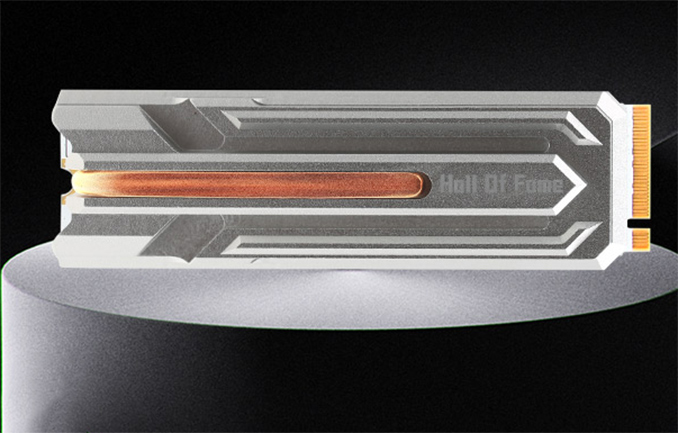
Palit Microsystems, which owns a number of GPU brands, entered SSD market a little more than two years ago with entry-level offerings to simplify product development and avoid competition. While Palit mainly sells ultra-high-end video cards and has loads of performance-minded clientele, for these customers the company is now rolling out its high-end GALAX Hall of Fame SSDs based on an advanced controller and featuring a sophisticated cooling system.
The GALAX Hall of Fame drives are based on Phison’s PS5012-E12 controller (NVMe 1.3, eight NAND channels with 32 CE targets, a DDR4/DDR3L interface for DRAM caching, LDPC, etc.), Toshiba’s BiCS 3D NAND flash (256 Gb 64L 3D TLC is the most likely), and feature a PCIe 3.1 x4 interface. The drives are offered in 512 GB, 1 TB, and 2 TB configurations, which to a large degree emphasizes their premium positioning.
Depending on the version, the HOF SSDs come in M.2-2280 module as well as HHHL card form-factors. The latter features a CNC-machined cooling system with a heat pipe to ensure consistent performance of the drives under high loads, whereas the former has a typical heatsink as well as RGB LEDs controlled using proprietary software.
When it comes to performance, the drives offer something that one would expect from a Phison PS5012-E12-powered device. The GALAX Hall of Fame SSDs claim to provide up to 3400 MB/s sequential read speeds, up to 3000 MB/s sequential write speeds (2 TB HHHL version, see the table below for exact specs of other drives), as well as up to 460K/660K random read/write IOPS. Meanwhile, it is noteworthy that similarly configured M.2 and HHHL drives are rated for different performance levels, which means that the SSDs are tuned differently (possibly because of heat dissipation of the controller).
| GALAX HOF SSDs Specifications | |||
| Capacity | 512 GB | 1 TB | 2 TB |
| Controller | Phison PS5012-E12 | ||
| NAND Flash | Toshiba 64-layer BiCS3 3D TLC (?) | ||
| Interface | PCIe 3.1 x4 | ||
| Form-Factor | M.2-2280 | M.2-2280 HHHL |
M.2-2280 HHHL |
| Sequential Read | 3.4 GB/s | 3.4 GB/s | 3.4 GB/s |
| Sequential Write | 2 GB/s | M.2: 2.8 GB/s HHHL: 3 GB/s |
M.2: 2.8 GB/s HHHL: 3 GB/s |
| Random Read IOPS | 400,000 | M.2: 400,000 HHHL: 440,000 |
M.2: 400,000 HHHL: 440,000 |
| Random Write IOPS | 540,000 | M.2: 600,000 HHHL: 660,000 |
M.2: 600,000 HHHL: 660,000 |
| Idle Power Consumption | < 900 mW (?) | ||
| PCIe L1.2 Idle | < 2 mW (?) | ||
| Pseudo-SLC Caching | Yes | ||
| DRAM Buffer | Yes | ||
| TCG Opal Encryption | Yes | ||
| Warranty | 3 years | ||
One interesting feature of the GALAX Hall of Fame SSDs is bundled Xtreme Tuner For SSD utility designed by the company. The program supports monitoring of the drive (temperature, endurance, etc.), can upgrade its firmware, and even optimize performance. Considering the fact that Phison usually supervises manufacturing of SSDs based on its controllers and essentially sells SSDs, not controller chips, the fact that GALAX now offers software for customization of its PS5012-E12-powered drives means that the company has done some additional R&D work and its products offer more than typical Phison-based SSDs do.
At present, the GALAX HOF SSDs are available primarily in China. It remains to be seen whether Palit decides to offer them in other countries and which trademarks they will carry.
Related Reading:
- The Silicon Power P34A80 SSD Review: Phison E12 With Newer Firmware
- CES 2019: GIGABYTE’s High-Performance Aorus PCIe and M.2 SSDs
- Phison: PS5012-E12 Controller in Mass Production, 20+ SSDs Incoming
- The Phison E12 Reference Design Preview: A Next-Gen NVMe SSD Controller
Source: GALAX, GALAX (via Momomo_US/Twitter)


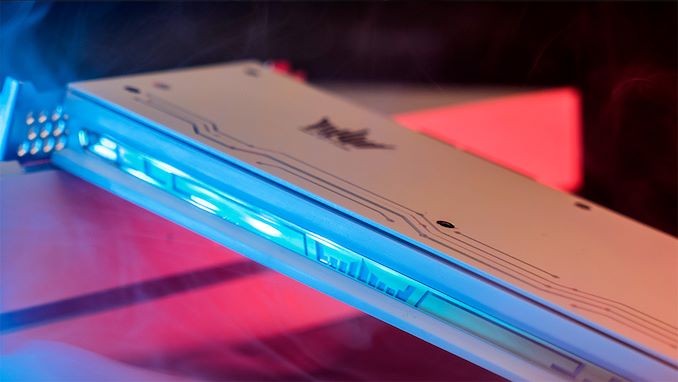
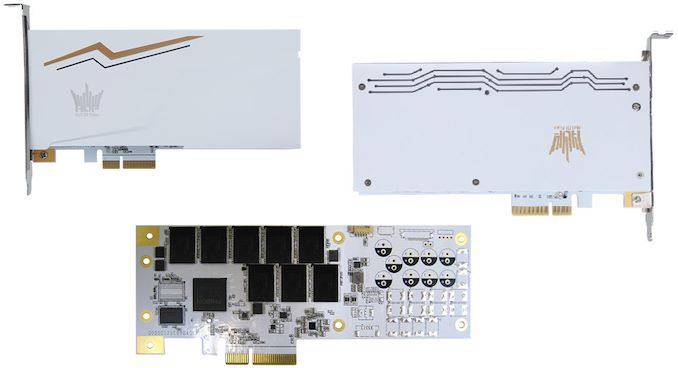
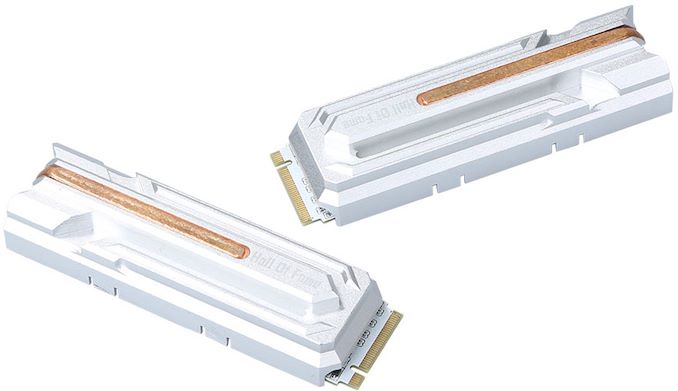
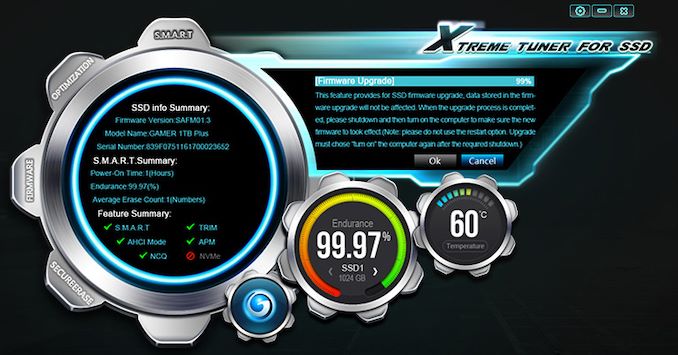









20 Comments
View All Comments
XabanakFanatik - Thursday, March 28, 2019 - link
Extremely displeased with the gigantic waste of space where they aren't putting power loss protection for the HHHL aib version.I'd think with their target market they would put even a slight amount of effort to make it a card that won't block all the fans on your giant HOF GPU, but instead they apparently just don't care.
DanNeely - Thursday, March 28, 2019 - link
Their target market is only interested in upspending from base models for frag harder disco lights. They made the right (but still terrible) design choice.Koenig168 - Thursday, March 28, 2019 - link
"While Palit mainly sells ultra-high-end video cards" - nope. Palit is a budget brand, so is Galax. The exception is the Galax HOF series which is indeed high-end.Great product, it's about time someone (in addition to WD) came up with decent heatsinks for NVMe SSDs.
Death666Angel - Friday, March 29, 2019 - link
So the Palit GTX 1080 I bought a couple years ago was not a high end card? You are one funny man.OolonCaluphid - Friday, March 29, 2019 - link
They do cheap stuff. Where did it fit in the line up of pricing? Did you buy it because it was high end, or because it was cheap compared to other GTX 1080's? Not saying it's bad, I've had a Palit GXT 1070ti which was a great card, but undoubtedly built down to a price.flyingpants265 - Sunday, March 31, 2019 - link
No, it's a low-end GTX1080OolonCaluphid - Friday, March 29, 2019 - link
>it's about time someone (in addition to WD) came up with decent heatsinks for NVMe SSDs.Why? In most cases they simply don't need them. This thing has a gimicky heat pipe which will do little to dissipate heat, but does render it useless for laptop installation, and might interfere withsome bigger GPU coolers depending where on the baord it goes.
Most NVME drives have a metallic sticker, and in reality that is all they need for 955 of usage cases. For the 5% a thermal pad and stick of aluminium meets the threshold, like most high end motherboard have anyway.
Koenig168 - Friday, March 29, 2019 - link
I agree that most NVMe SSDs do not need heatsinks. However, there is a minority of users who want heatsinks whether for aesthetic reasons or to keep operating temperatures lower.Dragonstongue - Friday, March 29, 2019 - link
pretty much, the difference is a heatsink done right actually helps SSD especially modern ones as they get faster and faster and NEED a propr heatsink (for the fast as lightning ones of course) not to mention electronics like to stay at a medium heat level vs spiking up and down.some like MSI heatshield attempts are just terribad, that being said this is not like DDR4 @1.25-1.35v where they do not need ram sinks at all where older gens might have needed, whereas drive wise they did not need much of any heatsink ability but now being nvme etc etc if consumers expect certain performance levels constantly the only way maybe to achieve that is via heatsinks so not throttle etc.
granted majority not need this, and the "few" that actually use these crazy speed drives vs slower ones is a small fraction.....hmmmmmm
Samus - Friday, March 29, 2019 - link
Now I've seen it all.So not only does it not fit in a laptop or mobile device anymore, but the target market, desktop pc's, could realistically put a $3 80mm fan on it that would probably perform better.